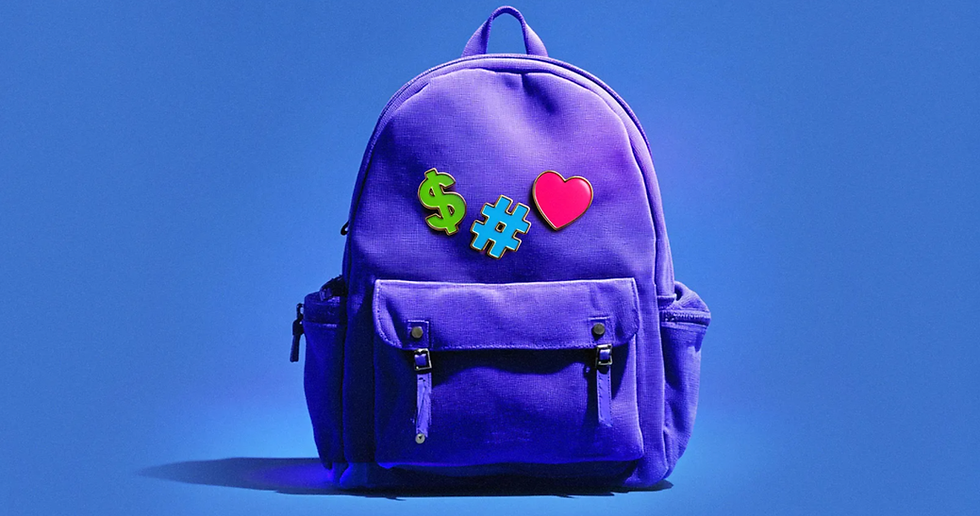Back-to-School, Elevated: How Nuuly and JanSport Are Winning Gen Z's Shopping Season
- InsightTrendsWorld

- Aug 16
- 4 min read
Why It’s Trending: Smart Spending Meets Cultural Resonance
Budget Tensions, High StakesWith U.S. back-to-school spending projected at around $128 billion, retailers face a tightrope: consumers expect value amid inflation and tariff pressures, and nearly half say rising prices are squeezing their buying power.
Gen Z’s Influence PeaksDespite financial strain, brands see exciting opportunities—Gen Z students are highly digitally active, socially influenced, and searching for practical-yet-cool deals.
Overview: Digital Native Strategies in a Super-Bowl Moment
For brands marketing to Gen Z during the late summer, back-to-school is more than a season—it’s a cultural spike. These brands are leaning heavily on authentic digital creativity, not just ads. From Nuuly’s creator-led subscription push to JanSport’s bag-as-character storytelling, success comes from blending narrative, humor, and platform-native content.
Detailed Findings: Tactics Across the Back-to-School Ecosystem
Nuuly: Subscription Sensibility Meets Creator Culture
Student Discounts Drive TractionLaunched in 2024, Nuuly’s student discount played a critical role in capturing Gen Z interest, and the brand now reaches over 300,000 subscribers—just as it enters its first profitable year.
Influencer Activity Over AdsNuuly prioritizes TikTok influencers over explicit branded advertising, catering to Gen Z’s preference for content that feels organic and creative.
"Cluub" Ambassador ProgramA user-generated content (UGC) rewards system encourages subscribers to create and share content—driving both engagement and authenticity, without specifying spend breakdowns.
Emerging Platforms and Streaming ChannelsBeyond TikTok and Meta, Nuuly extended its paid media to Snapchat, Reddit, Hulu, Peacock, Netflix, and Amazon Prime—highlighting a willingness to experiment with high-engagement platforms.
JanSport: Puppets, Punk Ballads & Vaulted Sales
Absurdity as AuthenticityReturning with its "Always With You" campaign—backpack puppets that sing, fall in love, or even “rot”—JanSport leans into comedic absurdity that feels raw, relatable, and widely relatable.
Historic ImpactThe prior campaign marked JanSport’s highest-grossing month in nearly six decades, driven by music-forward, meme-ready storytelling.
Performance Metrics SoaringTikTok view-through rates hit 99%; YouTube engagement was up 86%, and search interest rose 4.5X. Viewers reported rewatching ads multiple times—indicating both reach and memorability.
Emotional Loyalty MessagingInstead of pushing features, the brand’s messaging positions backpacks as lifelong companions—durable, emotionally resonant — resounding deeply with Gen Z.
American Eagle: Streaming Stars & Snap Filters
Casting Social IconsSydney Sweeney became the face of the season, integrated via HBO Max placements and snap-filter campaigns—bringing lifestyle credibility and platform-native visibility.
Multi-Channel Paid StrategyPaid media covers YouTube, Instagram, CTV, Snapchat, and BeReal—reaching Gen Z where they live and scroll, via visual and immersive formats.
Key Success Factors: Why These Campaigns Work
Play First, Sell SecondAuthentic humor and storytelling—not product features — draw attention and drive conversation.
Creator CredibilityWhether via influencer videos or puppet music spots, content feels less sold and more shared.
Platform FluidityBrands are meeting Gen Z across platforms—TikTok, Snapchat, streaming, Reddit—matching media type to message.
Emotional PositioningProducts feel like companions or cultural moments—not transactions. That builds brand loyalty.
Key Takeaway: Capture Culture, Not Just Carts
In a season where budgets are tight and attention is fragmented, brands win by being culturally present, emotionally engaging, and platform‑savvy—not just by dropping deals or discounts.
Main Strategy: Content-First Commerce
Top-performing brands are prioritizing content crafted for the scroll—funny, authentic, and shareable—within a buying environment.
Description of the Trend: “Scroll-Ready Shopping”
Back-to-school campaigns are now judged not by pushy sale lines, but by whether they spark shares, memes, and a sense of “this gets me.”
Key Characteristics
Native Storytelling: Campaigns built from the inside out for the platforms they appear on.
Emotional Anchors: Humor, companionship, and realness driving product momentum.
Cross-Platform Strategy: TikTok, Snapchat, Reddit, streaming—all amplified by influencers.
Value via Culture: Items become symbols, not just supplies.
Consumer Motivation
Connection over Consumption: Gen Z values stories, not pitches.
Authenticity Always: Rough edges and thematic absurdity feel more honest than polished mesmerism.
Platform Alignment: Discoverability is native—ads must feel like content, not interruptions.
Emerging Behavior
Preference for UGC-enabled communities like Nuuly’s “Cluub.”
Replay-driven engagement—ads that are watched, shared, and discussed.
Purchase impact tied to emotional activation, not just price or features.
Retailer Implications
Consumers: Seek brands that entertain as much as outfit them.Brands: Must invest in creator infrastructure, not just ad budgets.Retailers: Should curate cultural moments—not just products—to win Gen Z.
Strategic Forecast
Short-Term: Back-to-school seasons rely on absurdist, shareable narratives.
Mid-Term: UGC and streaming media become as critical as traditional advertising.
Long-Term: Brands will need identity, emotion, and cultural relevance to stay “on scroll.”
Innovation Ideas
Backpack Micro-Stories – short UGC assets where products narrate user experiences.
Creator-Driven Subscription Boxes – curated back-to-school essentials with influencer merch.
Mini-Puppet Product Commercials – product-as-character content for portability.
AR Packs in Stories – virtual try-ons via Snapchat/Instagram filters.
Community Launch Drops – reward Cluub-style ambassadors with early SKU releases.
Summary of Trends
Consumer Trend: Culture-Led Shopping
Social Trend: Meme-First Marketing
Strategy: Emotional-Empathy Advertising
Industry Shift: Friend-Feel Over Buy-Now
Motivation: Belonging via Brand Engagement
Final Thought: School Supply Meets Pop Culture
These campaigns teach a clear lesson: for Gen Z, getting noticed is not enough—you’ve got to get felt. When brands catch cultural rhythms—humor, weirdness, emotional resonance—they don’t just sell backpacks—they become part of how Gen Z tells its story.





Comments